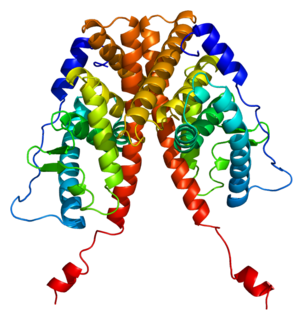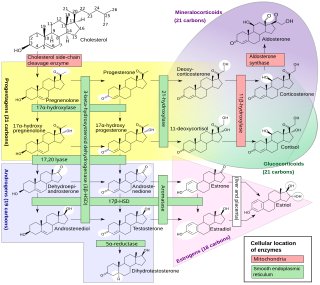| Hyperestrogenism | |
|---|---|
| Other names | Hyperestrogenic state, |
| Specialty | Endocrinology |
Hyperestrogenism, hyperestrogenic state, or estrogen excess, is a medical condition characterized by an excessive amount of estrogenic activity in the body. [1]
| Hyperestrogenism | |
|---|---|
| Other names | Hyperestrogenic state, |
| Specialty | Endocrinology |
Hyperestrogenism, hyperestrogenic state, or estrogen excess, is a medical condition characterized by an excessive amount of estrogenic activity in the body. [1]
Signs of hyperestrogenism may include heightened levels of one or more of the estrogen sex hormones (usually estradiol and/or estrone), lowered levels of follicle-stimulating hormone and/or luteinizing hormone (due to suppression of the hypothalamic–pituitary–gonadal axis by estrogen), and lowered levels of androgens such as testosterone (generally only relevant to males). [1] Symptoms of the condition in women may consist of menstrual irregularities, amenorrhea, abnormal vaginal bleeding, and enlargement of the uterus and breasts. [1] [2] It may also present as isosexual precocity in children [1] [2] and as hypogonadism, gynecomastia, feminization, impotence, and loss of libido in males. [3] If left untreated, hyperestrogenism may increase the risk of estrogen-sensitive cancers such as breast cancer later in life.[ citation needed ]
Hyperestrogenism can be caused by ovarian tumors, [2] genetic conditions such as aromatase excess syndrome (also known as familial hyperestrogenism), or overconsumption of exogenous sources of estrogen, including medications used in hormone replacement therapy and hormonal contraception. [3] Liver cirrhosis is another cause, though through lowered metabolism of estrogen, not oversecretion or overconsumption like the aforementioned. It's necessary to know there exist two kinds of hyperestrogenism: Absolute (more concentration than usual of estrogen) and relative (a normal concentration of estrogen, higher with respect to progesterone). An example of absolute hyperestrogenism could be: persistent follicles that later undergo atresia without ovulating; and the example of relative hyperestrogenism: luteal insufficiency.[ citation needed ]
| | This section is empty. You can help by adding to it. (February 2017) |
Treatment may consist of surgery in the case of tumors, [1] lower doses of estrogen in the case of exogenously-mediated estrogen excess, and estrogen-suppressing medications like gonadotropin-releasing hormone analogues and progestogens. In addition, androgens may be supplemented in the case of males.[ citation needed ]
Hormone therapy or hormonal therapy is the use of hormones in medical treatment. Treatment with hormone antagonists may also be referred to as hormonal therapy or antihormone therapy. The most general classes of hormone therapy are oncologic hormone therapy, hormone replacement therapy, androgen replacement therapy (ART), oral contraceptive pills, and transgender hormone therapy.
Anovulation is when the ovaries do not release an oocyte during a menstrual cycle. Therefore, ovulation does not take place. However, a woman who does not ovulate at each menstrual cycle is not necessarily going through menopause. Chronic anovulation is a common cause of infertility.
Hypogonadism means diminished functional activity of the gonads—the testes or the ovaries—that may result in diminished production of sex hormones.

Hyperandrogenism is a medical condition characterized by high levels of androgens. It is more common in women than men. Symptoms of hyperandrogenism may include acne, seborrhea, hair loss on the scalp, increased body or facial hair, and infrequent or absent menstruation. Complications may include high blood cholesterol and diabetes. It occurs in approximately 5% of women of reproductive age.

Aminoglutethimide (AG), sold under the brand names Elipten, Cytadren, and Orimeten among others, is a medication which has been used in the treatment of seizures, Cushing's syndrome, breast cancer, and prostate cancer, among other indications. It has also been used by bodybuilders, athletes, and other men for muscle-building and performance- and physique-enhancing purposes. AG is taken by mouth three or four times per day.

Exemestane, sold under the brand name Aromasin among others, is a medication used to treat breast cancer. It is a member of the class of antiestrogens known as aromatase inhibitors. Some breast cancers require estrogen to grow. Those cancers have estrogen receptors (ERs), and are called ER-positive. They may also be called estrogen-responsive, hormonally-responsive, or hormone-receptor-positive. Aromatase is an enzyme that synthesizes estrogen. Aromatase inhibitors block the synthesis of estrogen. This lowers the estrogen level, and slows the growth of cancers.
Hypoestrogenism, or estrogen deficiency, refers to a lower than normal level of estrogen. It is an umbrella term used to describe estrogen deficiency in various conditions. Estrogen deficiency is also associated with an increased risk of cardiovascular disease, and has been linked to diseases like urinary tract infections and osteoporosis.

Estrogen insensitivity syndrome (EIS), or estrogen resistance, is a form of congenital estrogen deficiency or hypoestrogenism which is caused by a defective estrogen receptor (ER) – specifically, the estrogen receptor alpha (ERα) – that results in an inability of estrogen to mediate its biological effects in the body. Congenital estrogen deficiency can alternatively be caused by a defect in aromatase, the enzyme responsible for the biosynthesis of estrogens, a condition which is referred to as aromatase deficiency and is similar in symptomatology to EIS.
Hormonal therapy in oncology is hormone therapy for cancer and is one of the major modalities of medical oncology, others being cytotoxic chemotherapy and targeted therapy (biotherapeutics). It involves the manipulation of the endocrine system through exogenous or external administration of specific hormones, particularly steroid hormones, or drugs which inhibit the production or activity of such hormones. Because steroid hormones are powerful drivers of gene expression in certain cancer cells, changing the levels or activity of certain hormones can cause certain cancers to cease growing, or even undergo cell death. Surgical removal of endocrine organs, such as orchiectomy and oophorectomy can also be employed as a form of hormonal therapy.
Ovarian diseases refer to diseases or disorders of the ovary.

Aromatase deficiency is a very rare condition characterised by extremely low levels or complete absence of the enzyme aromatase activity in the body. It is an autosomal recessive disease resulted from various mutations of gene CPY19 (P450arom) which can lead to delayed puberty in females, osteoporosis in males and virilisation in pregnant mothers. As of 2016, only 35 cases have been described in medical literature.
Hypergonadism is a condition where there is a hyperfunction of the gonads. It can manifest as precocious puberty, and is caused by abnormally high levels of testosterone or estrogen, crucial hormones for sexual development. In some cases, it may be caused by a tumor, which can be malignant, but is more commonly benign. Anabolic steroids may also be a major cause of high androgen and estrogen functional activity. Symptoms of the condition may include precocious puberty, rapid growth in adolescents, high libido, acne, excessive hairiness, and others.

Aromatase excess syndrome is a rare genetic and endocrine syndrome which is characterized by an overexpression of aromatase, the enzyme responsible for the biosynthesis of the estrogen sex hormones from the androgens, in turn resulting in excessive levels of circulating estrogens and, accordingly, symptoms of hyperestrogenism. It affects both sexes, manifesting itself in males as marked or complete phenotypical feminization and in females as hyperfeminization.

An inborn error of steroid metabolism is an inborn error of metabolism due to defects in steroid metabolism.
Gonadotropin-releasing hormone (GnRH) insensitivity also known as Isolated gonadotropin-releasing hormone (GnRH)deficiency (IGD) is a rare autosomal recessive genetic and endocrine syndrome which is characterized by inactivating mutations of the gonadotropin-releasing hormone receptor (GnRHR) and thus an insensitivity of the receptor to gonadotropin-releasing hormone (GnRH), resulting in a partial or complete loss of the ability of the gonads to synthesize the sex hormones. The condition manifests itself as isolated hypogonadotropic hypogonadism (IHH), presenting with symptoms such as delayed, reduced, or absent puberty, low or complete lack of libido, and infertility, and is the predominant cause of IHH when it does not present alongside anosmia.
Follicle-stimulating hormone (FSH) insensitivity, or ovarian insensitivity to FSH in females, also referable to as ovarian follicle hypoplasia or granulosa cell hypoplasia in females, is a rare autosomal recessive genetic and endocrine syndrome affecting both females and males, with the former presenting with much greater severity of symptomatology. It is characterized by a resistance or complete insensitivity to the effects of follicle-stimulating hormone (FSH), a gonadotropin which is normally responsible for the stimulation of estrogen production by the ovaries in females and maintenance of fertility in both sexes. The condition manifests itself as hypergonadotropic hypogonadism, reduced or absent puberty, amenorrhea, and infertility in females, whereas males present merely with varying degrees of infertility and associated symptoms.
Androgen deficiency is a medical condition characterized by insufficient androgenic activity in the body. Androgenic activity is mediated by androgens, and is dependent on various factors including androgen receptor abundance, sensitivity and function.

Gynecomastia is the abnormal non-cancerous enlargement of one or both breasts in males due to the growth of breast tissue as a result of a hormone imbalance between estrogen and androgen. Gynecomastia can cause significant psychological distress or unease.

Androstanolone, or stanolone, also known as dihydrotestosterone (DHT) and sold under the brand name Andractim among others, is an androgen and anabolic steroid (AAS) medication and hormone which is used mainly in the treatment of low testosterone levels in men. It is also used to treat breast development and small penis in males. It is typically given as a gel for application to the skin, but can also be used as an ester by injection into muscle.
Hypergonadotropic hypergonadism is an endocrine situation and subtype of hypergonadism in which both gonadotropin levels and gonadal function, such as sex hormone production, are abnormally high. It can be associated with hyperandrogenism and hyperestrogenism and with gonadal cysts and tumors. It can be caused by medications such as gonadotropins, gonadotropin-releasing hormone agonists, nonsteroidal antiandrogens, and selective estrogen receptor modulators, as well as conditions like human chorionic gonadotropin-secreting tumors, complete androgen insensitivity syndrome, and estrogen insensitivity syndrome.